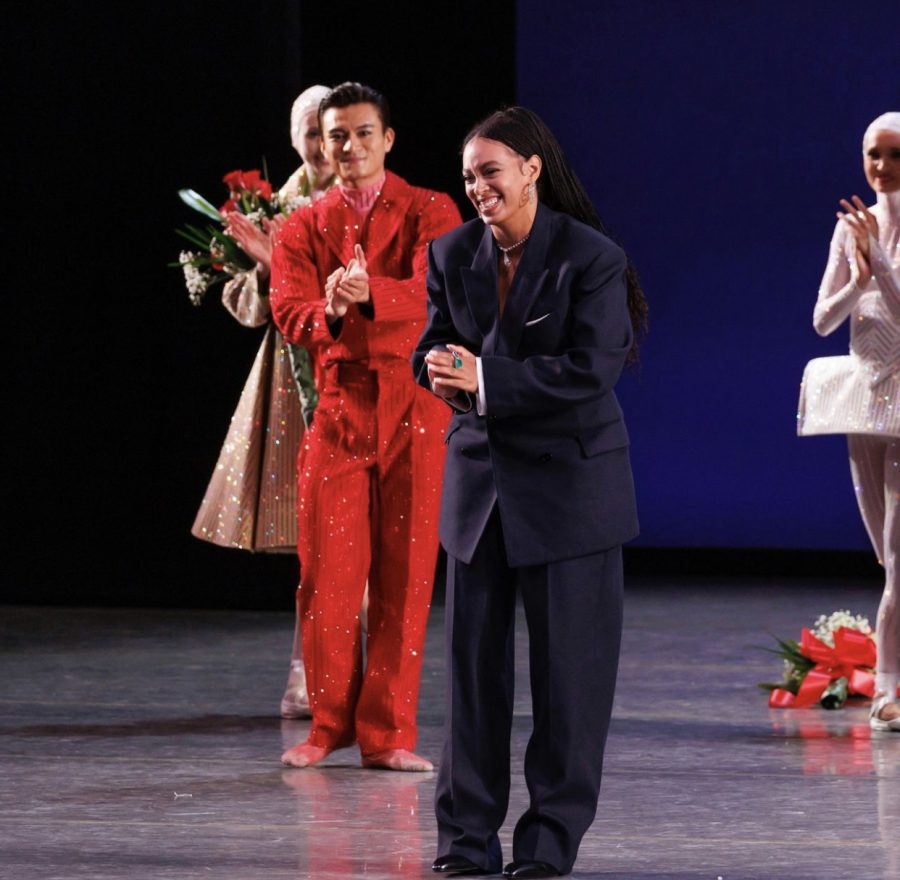New York City Ballet elegantly showcases Solange’s music
October 17, 2022
On Oct. 16, New Yorkers had the honor and privilege of experiencing a performance of the New York City Ballet ballet “Play Time” scored by Solange Knowles, an African American Grammy-winning artist. For Knowles’ ballet debut, she worked with Gianna Reisen, the youngest choreographer the NYCB has ever commissioned. Together, they established the foundations of the future of ballet through wondrous choreography and jazz and funk-inspired classical music.
The future and past coexisted for a night. Preceding “Play Time” was a George Balanchine piece, the founder and original choreographer of the NYCB. A quintessential portrayal of classical ballet, the Balanchine production consisted of all-white costumes (finished with crowns, headpieces and earrings, all created using Swarovski crystals), solemn yet smiling faces and calculated movements from the dancers who appeared to be following the same choreography but performed at slightly different tempos.
Throughout the performances, audience members Amy Zeng and Jen McIntosh discussed their thoughts on the first dance of the evening. “I don’t know much about the ballet, but I really like classical music. I thought the piece wasn’t really exciting… it felt like they were just doing the same thing a lot,” Zeng commented. “The only thing I could compare it to is ‘The Nutcracker,’ which I feel like is so dramatic and so exciting. Whereas, with this, I was like ‘oh it’s just kind of going along.’”
Once the curtain was lifted again in preparation for the second performance, there was an instant shift in disposition within the audience. It almost seemed cruel to adjoin these two performances in a single afternoon. After the initial visceral reactions from the audience, the impassioned dance began with the performers placing a hand on their hearts.
Dancers exhibited emotions that coincided with catharsis while their costumes were allocated for individuality and self-expression. Vibrant colors, experimental shapes and various silhouettes emphasized the dazzling shimmer that gleamed off of each piece as the dancers gracefully stepped in and out of the floodlights. With the elegant use of every piece of them, dancing became a form of self-expression that was mended with the gestures and facial expressions that the dancers exhibited.
Throughout Knowles’ score, the vibrant ballerinas and danseurs each had solo moments to fully portray the character and emotions they were designated. Oftentimes, when they interacted with each other, it was charmingly comical. McIntosh mentioned, “The performance felt a lot to me like a celebration of diversity. It almost reminded me of being on the streets of New York.”
When asked to compare the second and third scores, she mentioned, “[This] piece was very much just about individual loneliness. It felt really lonely…In Solange’s music, there was much more percussion and bass, where the [other] piece was almost entirely string.”
It was a delight to take notice of the various age groups and racial diversity in attendance to support these artists. Patrons within the audience strutted down the narrow aisles wearing a mix of formal attire, classic yet androgynous sharp black suits, designer handbags and ballet flats, contrasting with those who were delightfully accoutred in bright silk dresses, chic midi skirts or kitten heels.
The audience was receptive to each performance throughout the night, which required the dancers to repeatedly step in front and behind the curtain countless times to receive applause during their final appearances on stage. The dancers graciously continued the traditions in the exceptionally beautiful David H. Koch Theater as they continued to walk back and forth, taking their bows, for as long as the audience incentivized them with applause.
View this post on Instagram
Beyoncė Knowles-Carter expressed her praise for her sister in a congratulatory Instagram post stating, “My beloved sister, there are no words to express the pride and admiration I have for you. You are a visionary and one of one. Congratulations on being the first African American woman to compose for the New York City Ballet. The piece you composed is phenomenal. I love you deep. Might I suggest you don’t f— with my sis.”
Through certain dates in Oct. 2022 and May 2023, fellow ballet lovers and Knowles enthusiasts will be able to watch this performance in reverence.











